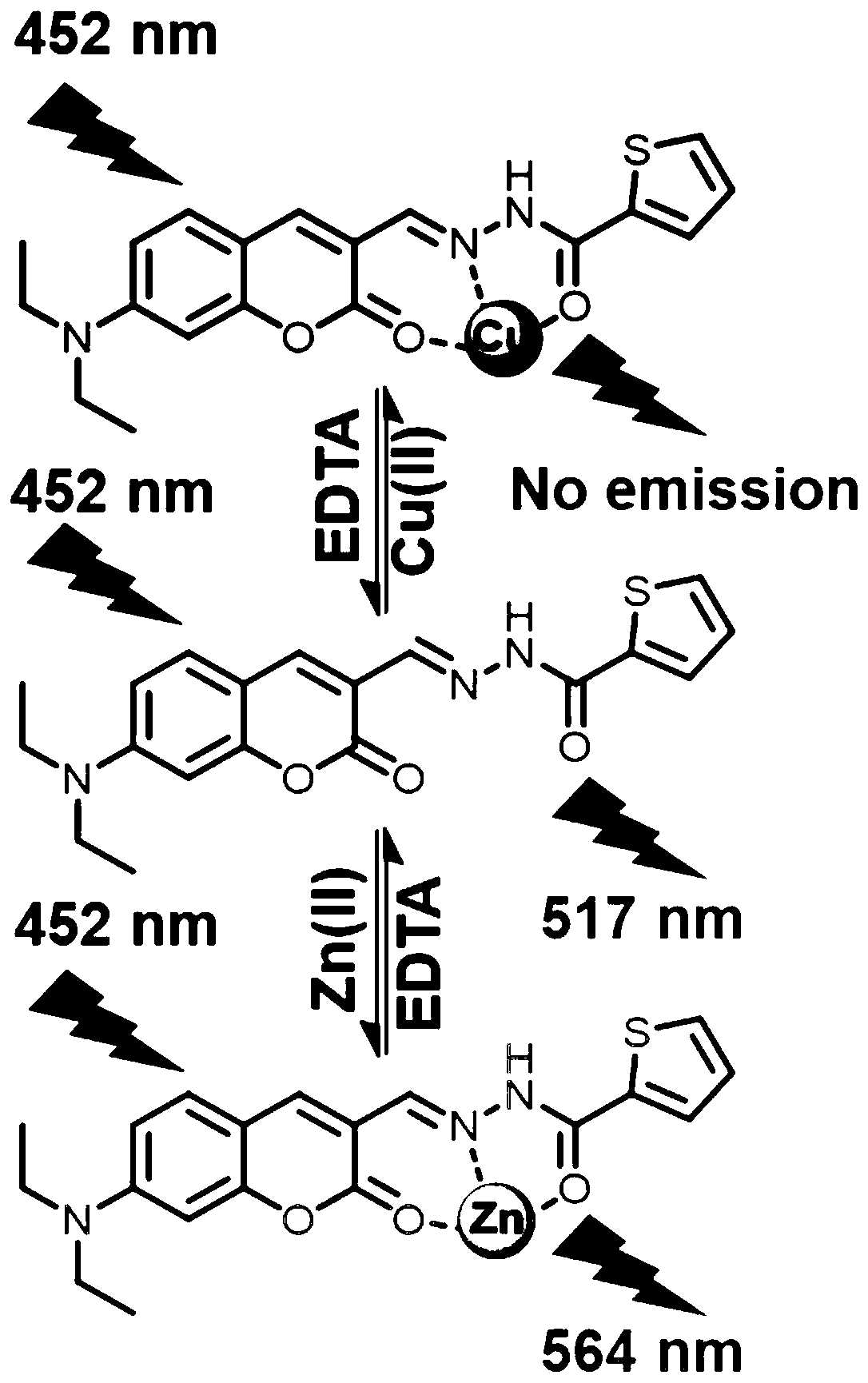Off-on type molecular fluorescent probe CMTAH and preparation method and application thereof
A fluorescent probe and molecular probe technology, applied in fluorescence/phosphorescence, chemical instruments and methods, analytical materials, etc., can solve the problem of few reports of probes for double metal ion recognition, and achieve good application prospects and synthesis methods. Simple, accurate detection of effects
- Summary
- Abstract
- Description
- Claims
- Application Information
AI Technical Summary
Problems solved by technology
Method used
Image
Examples
Embodiment 1
[0034] Preparation of Molecular Probe CMTAH in Example 1
[0035] To a solution of coumarin aldehyde (200 mg, 0.81 mmol) in absolute ethanol (EtOH, 30 mL) was added 2-thiophene hydrazide (116 mg, 0.81 mmol). After reflux and mixing at room temperature for 16 hours, filter with a Buchner funnel after the reaction, and wash the filter cake with ethanol to obtain CMTAH as a yellow solid. The above-mentioned yellow solid powder is dissolved in ethanol, then heated and stirred for filtration, and the filtrate is slowly volatilized to obtain 256 mg of yellow solid powder, yield: 85%, can confirm that the product is the target small molecule probe by H NMR spectrum and C NMR spectrum, such as Figure 10-11 shown.
[0036] The roadmap for the synthesis of small molecule probes is shown in figure 1 as shown, figure 1 Represents the roadmap for the synthesis of small molecule probes, where EtOH is ethanol.
[0037] 1 H NMR (500MHz, DMSO) δ12.73–11.05(m,1H),8.68–7.77(m,4H),7.63(d,J=...
Embodiment 2
[0039] The binding mode of molecular probe to copper ion and zinc ion in embodiment 2
[0040] The molecular probe emits green fluorescence at 517nm under the excitation wavelength of 452nm. When it is combined with copper ions, the fluorescence is quenched; when the probe is combined with zinc ions, it emits yellow fluorescence at a wavelength of 564nm, and its binding simulation diagram is as follows figure 2 shown.
Embodiment 3
[0041] Molecular probe in embodiment 3 is to the ultraviolet and fluorescence spectrum of copper ion and zinc ion recognition
[0042] 10 μM Molecular Probes EtOH-H 2 O solution (v / v, = 1:10). A solution of copper ions and zinc ions with the same concentration was added dropwise to the probe solution.
[0043] Such as image 3 As shown in A, after copper ions are added to the probe solution, as the concentration of copper ions increases (0.00-0.90eq), the absorption band at 455nm decreases gradually, and two new absorption peaks appear at 365nm and 530nm, and The maximum absorption peak appears at 365nm, and its absorption intensity increases gradually with the increase of copper ion concentration. At the same time, the naked eye can observe the obvious color change of the probe solution: from green to colorless, and the stoichiometric ratio of the two is 1: 1.
[0044] Such as image 3 As shown in B, after adding zinc ions to the probe solution, with the increase of zinc...
PUM
 Login to View More
Login to View More Abstract
Description
Claims
Application Information
 Login to View More
Login to View More - Generate Ideas
- Intellectual Property
- Life Sciences
- Materials
- Tech Scout
- Unparalleled Data Quality
- Higher Quality Content
- 60% Fewer Hallucinations
Browse by: Latest US Patents, China's latest patents, Technical Efficacy Thesaurus, Application Domain, Technology Topic, Popular Technical Reports.
© 2025 PatSnap. All rights reserved.Legal|Privacy policy|Modern Slavery Act Transparency Statement|Sitemap|About US| Contact US: help@patsnap.com



